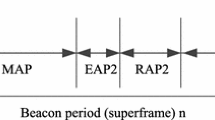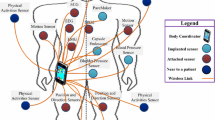Abstract
Wireless body area networks (WBANs) is a technology that offers better methods for real-time patient health monitoring. By the year 2025, industry and academia estimate up to 3 billion wearable sensors placed in different WBANs, gathering health data from patients and sending them to medical servers. However, data transmission from WBANs to those medical servers is still a challenging task. In particular, wireless transmission can result in high latency and low throughput due to interference, which causes risks to healthcare patients. The existing solutions address wireless transmission interference inside the same WBAN or the interference that one WBAN can make on another. These solutions rarely cope with both interferences from a medical application perspective. In this article, we detail PDAC, a medical application-aware MAC-layer P rotocol for D ynamic Channel A lloC ation. At a glance, PDAC takes advantage of the existence of multiple base stations in the most common wireless network environments. In this sense, it orchestrates the cooperation among base stations, even in dense medical-hospital environments, by properly allocating co-located wireless body area networks. PDAC relies on a greedy solution for a graph coloring problem to reduce interferences and enhance data communication. According to evaluations, we observe an average increase of 30% on the system throughput and an average reduction of 40% in the system latency when compared to a baseline solution.










Similar content being viewed by others
References
Omeni O, Wong A C W, Burdett A J, Toumazou C (2008) Energy Efficient Medium Access Protocol for Wireless Medical Body Area Sensor Networks. IEEE Trans Biomed Circ Syst 2(4):251–259
Elayan H, Shubair R M, Kiourti A (2017) Wireless Sensors for Medical Applications: Current Status and Future Challenges. In: Proceedings of the IEEE European Conference on Antennas and Propagation (EUCAP), pp 2478–2482
Varshney U (2007) Pervasive Healthcare and Wireless Health Monitoring. Mob Netw Appl 12 (2-3):113–127
European Commission (2016) Smart Wearables: Reflection and Orientation Paper. http://ec.europa.eu/newsroom/document.cfm?doc_id=40542. Online; accessed 09 September 2017
Movassaghi S, Abolhasan M, Lipman J, Smith D, Jamalipour A (2014) Wireless Body Area Networks: A Survey. IEEE Commun Surv Tutorials 16(3):1658–1686
Phunchongharn P, Hossain E, Niyato D, Camorlinga S (2010) A Cognitive Radio System for E-health Applications in a Hospital Environment. IEEE Wirel Commun 17(1):20–28
Antonescu B, Basagni S (2013) Wireless Body Area Networks: Challenges, Trends and Emerging Technologies. In: Proceedings of the 8th International Conference on Body Area Networks, pp 1–7
Fang G, Dutkiewicz E, Yu K, Vesilo R, Yu Y (2010) Distributed Inter-Network Interference Coordination for Wireless Body Area Networks. In: Proceedings of the IEEE GLOBECOM, pp 1–5
Baker S D, Hoglund D H (2008) Medical-Grade, Mission-Critical Wireless Networks - Designing an Enterprise Mobility Solution in the Healthcare Environment. IEEE Eng Med Biol Mag 27(2):86–95
Yu J-Y, Liao W-C, Lee C-Y (2006) A MT-CDMA Based Wireless Body Area Network for Ubiquitous Healthcare Monitoring. In: Proceedings of the IEEE Biomedical Circuits and Systems Conference, pp 98–101
Doost-Mohammady R, Chowdhury K R (2012) Transforming Healthcare and Medical Telemetry Through Cognitive Radio Networks. IEEE Wirel Commun 19(4):67–73
Lee B, Yun J, Han K (2011) Dynamic Channel Adjustable Asynchronous Cognitive Radio MAC Protocol for Wireless Medical Body Area Sensor Networks. In: Communication and Networking, vol 266, pp 338–345
Boulis A, et al. (2011) Castalia: A Simulator for Wireless Sensor Networks and Body Area Networks. NICTA: National ICT Australia
Cremonezi B M, Vieira A B, Nacif J A M, Nogueira M (2017) A Dynamic Channel Allocation Protocol for Medical Environment under Multiple Base Stations. In: Proceedings of the IEEE Wireless Communications and Networking Conference (WCNC), pp 1–6
Liu B, Yan Z, Chen C W (2013) MAC Protocol in Wireless Body Area Networks for E-health: Challenges and a Context-aware Design. IEEE Wirel Commun 20(4):64–72
Huang P, Xiao L, Soltani S, Mutka M W, Xi N (2013) The evolution of mac protocols in wireless sensor networks: A survey. IEEE Commun Surv Tutorials 15(1):101–120
Demirkol I, Ersoy C, Alagoz F (2006) MAC Protocols for Wireless Sensor Networks: a Survey. IEEE Commun Mag 44(4):115–121
Ullah S, Higgins H, Braem B, Latre B, Blondia C, Moerman I, Saleem S, Rahman Z, Kwak K S (2012) A Comprehensive Survey of Wireless Body Area Networks. J Med Syst 36(3):1065– 1094
Rajendran V, Obraczka K, Garcia-Luna-Aceves J J (2006) Energy-efficient, Collision-free Medium Access Control for Wireless Sensor Networks. Wirel Netw 12(1):63–78
Ullah S, Khan P, Ullah N, Saleem S, Higgins H, Kwak K S (2010) A Review of Wireless Body Area Networks for Medical Applications. arXiv:1001.0831
Pervez Khan M, Hussain A, Kwak K S (2009) Medical Applications of Wireless Body Area Networks. Int J Digital Content Technol Appli
Li Y, Ye W, Heidemann J (2005) Energy and Latency Control in Low Duty Cycle MAC Protocols. In: IEEE Wireless Communications and Networking Conference, vol 2, pp 676– 682
Movassaghi S, Abolhasan M, Smith D (2014) Smart Spectrum Allocation for Interference Mitigation in Wireless Body Area Networks. In: IEEE International Conference on Communications (ICC), pp 5688–5693
Safaric S, Malaric K (2006) ZigBee Wireless Standard. In: IEEE Proceedings ELMAR 2006, pp 259–262
Katzela I, Naghshineh M (1996) Channel Assignment Schemes for Cellular Mobile Telecommunication Systems: A Comprehensive Survey. IEEE Pers Commun 3(3):10–31
Kyasanur P, Vaidya N H (2006) Routing and Link-layer Protocols for Multi-channel Multi-interface Ad HOC Nireless networks. ACM SIGMOBILE Rev 10(1):31–43
Subramanian A P, Das S R (2010) Addressing Deafness and Hidden Terminal Problem in Directional Antenna Based Wireless Multi-hop Networks. Wirel Netw 16(6):1557–1567
Abbasi S, Ismaili I A, Khuhawar F Y, et al. (2016) An Effective Channel Allocation Scheme to Reduce Co-channel and Adjacent Channel Interference for WMN Backhaul. Mehran Univ Res J Eng Technol 35(4):577
Cheng S H, Huang C Y (2013) Coloring-Based Inter-WBAN Scheduling for Mobile Wireless Body Area Networks. Trans Parallel Distrib Syst 24(2):250–259
Cheng S, Huang C, Tu C C (2011) RACOON: A Multiuser QoS Design for Mobile Wireless Body Area Networks. Springer J Med Syst 35(5):1277–1287
Yuan X, Li C, Song Y, Yang L, Ullah S (2015) On energy-saving in e-healthcare: a directional mac protocol for wban. In: Proceedings of the IEEE Globecom Workshops (GC Wkshps), pp 1–6
Maheshwari R, Gupta H, Das S R (2006) Multichannel MAC Protocols for Wireless Networks. In: Sensor and Ad Hoc Communications and Networks, 2006. SECON’06. 2006 3rd Annual IEEE Communications Society on, vol 2, pp 393–401
Khan Z, Ahmadi H, Hossain E, Coupechoux M, DaSilva L A, Lehtomäki J J (2014) Carrier Aggregation/Channel Bonding in Next Generation Cellular Networks: Methods and Challenges. IEEE Netw 28(6):34–40
Van Dam T, Langendoen K (2003) An Adaptive Energy-Efficient MAC Protocol for Wireless Sensor Networks. In: Proceedings of the 1st ACM International Conference on Embedded Networked Sensor Systems, pp 171–180
Bukhari S H R, Rehmani M H, Siraj S (2016) A Survey of Channel Bonding for Wireless Networks and Guidelines of Channel Bonding for Futuristic Cognitive Radio Sensor Networks. IEEE Commun Surv Tutorials 18(2):924–948
Funding
This work has been supported by CNPq, CAPES, FAPEMIG and FAPPR.
Author information
Authors and Affiliations
Corresponding author
Additional information
Publisher’s note
Springer Nature remains neutral with regard to jurisdictional claims in published maps and institutional affiliations.
Rights and permissions
About this article
Cite this article
Cremonezi, B.M., Vieira, A.B., Nacif, J.A. et al. A dynamic channel allocation protocol for medical environment. Ann. Telecommun. 76, 483–497 (2021). https://doi.org/10.1007/s12243-020-00826-8
Received:
Accepted:
Published:
Issue Date:
DOI: https://doi.org/10.1007/s12243-020-00826-8




